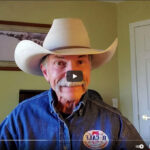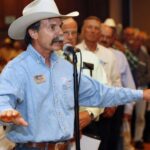By Robert Pore
robert.pore@theindependent.com

Dwindling support for a National Animal Identification System (NAIS) has one Nebraska livestock organization calling on state livestock producers to reject the idea of making the program mandatory.
State producers will have an opportunity on Tuesday to speak their minds about the future of a National Animal Identification System as the U.S. Department of Agriculture has added Nebraska as one of its stops on a national listening tour gathering information on the pros and cons on NAIS.
According to Dave Wright, president of the Independent Cattlemen of Nebraska, his organization is urging ranchers and farmers from across the state to attending the Nebraska NAIS meeting.
Wright said that after five years of voluntary compliance, support for NAIS is very low.
“ICON wants the USDA to see no thread of hope in the cattle country of Nebraska,” he said.
Wright said if the current voluntary system becomes mandatory, the program would fail because the cost of the electronic equipment needed for the tracking system would be “detrimental to the small producer, especially in recent years when profit margins have been almost nonexistent.”
He said both ICON and R-CALF USA question the reliability of the equipment. ICON is an affiliate of R-CALF USA.
“It could be affected or corrupted by any number of processes — loss of electricity, inaccurate information, computer viruses and even capability of producers to operate the delicate equipment in remote areas,” Wright said. “Members also question who can access this information.”
Another flaw, he said, that should “greatly concern cattlemen” is the lack of state jurisdiction.
“All livestock would be treated as one big herd,” Wright said. “The movement of cattle from one location to another is also questionable when one considers a broken fence and herds mixing together.”
He said the program wold be easy for a confined feedlot but would be difficult to implement for cow-calf herds and ranchers.
“How it will deal with livestock lost because of predators, theft or hunters is another question ranchers have,” Wright said.
A great concern, he said, is just how far NAIS can go.
“There is no law to give boundaries to the program,” Wright said. “Livestock owners are very worried about their Fourth Amendment right, which guards against unlawful searches and seizures.”
What concerns Wright is whether U.S. cattle producers will eventually be dictated to by a “global organization” and whether the new program will be a tool for disease eradication or disease and management and control.
Current Nebraska livestock officials are concerned about an outbreak of bovine tuberculosis in Nebraska.
The state’s congressional delegation is asking the USDA, in behalf of the state of Nebraska, for additional assistance to address the TB problem.
What is at stake, the delegation said in a letter recently sent to Agriculture Secretary Tom Vilsack, is the impact of the TB outbreak on the economic viability of the state’s billion-dollar cattle industry.
According to Nebraska’s congressional delegtation, 15,000 head of cattle have been quarantined for testing with the TB exposure risk across Nebraska, Colorado and South Dakota.
“This is not just a Nebraska issue or a Midwest issue,” the delegation said in its letter to Vilsack. “Considering the significant amount of beef produced in the Midwest, this problem could affect the beef industry nationwide. The scope and seriousness of this problem demand a federal response.”
Under the proposed National Animal Identification System, its goal is to protect “the health of U.S. livestock and poultry and the economic well-being of those industries by being able to quickly and effectively trace an animal disease to its source.”
According to the USDA, when a disease outbreak occurs, animal health officials need to know:
— Which animals are involved in a disease outbreak
— Where the infected animals are currently located
— What other animals might have been exposed to the disease
Wright said R-CALF and ICON officials are offering “a practical solution for disease management and control.”
He said they want to see disease prevented by limiting foreign sources of beef to our country.
“If imported, the cattle must be tagged or branded with a distinguishable mark, meet health codes and feed standards already required in this country,” Wright said. “Require TB testing – especially on cattle from Mexico. Test imported feed and bone meal.”
He said cattlemen have been very pleased with the current program for disease control within the United States.
They are asking the USDA to follow the directive of the current program and “leave the power of control with each state and tribal livestock office, which have been very successful over the years, but also ask for federal support of these programs with financing.”
“All cattlemen would like to see an increased surveillance of BSE and a tracking system set up for tracking interstate movement of cattle which originate in countries which have a BSE problem,” Wright said. “A disease program should be created for wildlife, which can contaminate a domestic herd of cattle.”





Thank you! I would now go on this blog every day!
Thank you
Eremeeff
Hi! I was surfing and found your blog post… nice! I love your blog. 🙂 Cheers! Sandra. R.
Oh no no no no WAY are we doing agritourism, bro! The whole point of farmnig is NOT to have to nuzzle bums for a living. : D (We’re thinking we might build a cabin on the other side of the property in case parents want to move in, and renting it out in the meantime, but that’s AS close as it’s gonna get.) Maybe the farm (ranch) tour is a western-states tradition? I went to ag school out in Utah and from the sound of it the ranchers would invite everyone (read: neighbors and the local Soil Conservation Service/FWS/BLM agents) over every once in a while for a farm tour barbecue. Often they’d have one after adopting some crazy newfangled range-management technique that had only been around for, say, twenty or thirty years once they worked out the kinks and it proved to be less of a disaster than everyone had told them it would be, it was a nice congenial way to let all the neighbors know that it really did work and they’d really known exactly what they were up to the whole time. The amount of concern by the gov’t and environmental groups over the health of these huge tracts of land probably helped prompt this- ranchers found out they had to defend themselves and find a good way to publicize the fact that ranches could be run in an environmentally-friendly way (and better than subdivisions, in any case). Inviting people on in worked for them. They could see the land with their own eyes (and perhaps the stark contrast between theirs and their no-account neighbor’s, wink wink nudge nudge), and you have a captive audience with your local gov’t agents for the better part of a day. Also when you’re on a 500 sqm ranch, maybe it’s the only time you ever see the neighbors except when you’re arguing over who’s supposed to have their ditch on that day.